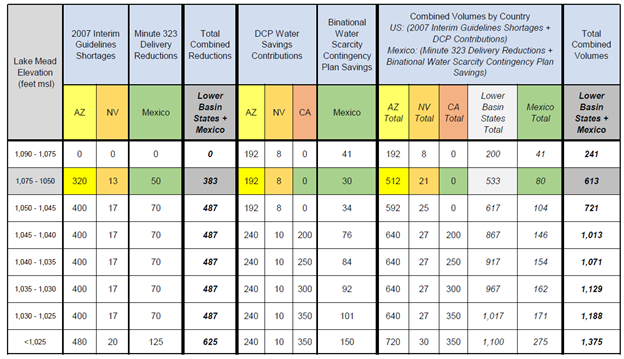Drought and Colorado River Declared Shortage
Southern Nevada relies on the water stored behind our iconic Hoover Dam in Lake Mead to supply our region with drinking water, as well as water for various other uses. Over the last 25 years, the Colorado River has suffered the worst drought in history causing Lake Mead to decline to unprecedented levels. Due to the prolonged lack of precipitation, low snowpack, dry soil conditions and increasing temperatures, the residents and industries located in the lower basin of the Colorado River including southern Nevada, will be required to reduce water use to help maintain critical elevations in Lake Mead.
Through water contracts, shortage guidelines and drought agreements, including the 2007 Colorado River Interim Guidelines for Lower Basin Shortages and Coordinated Operations for Lake Powell and Lake Mead (Interim Guidelines) and the Colorado River Drought Contingency Plan (DCP), the Colorado River Commission works closely with the United States Bureau of Reclamation (Reclamation), the Southern Nevada Water Authority (SNWA) and the other basin states, tribes, NGOs, and stakeholders as well as the Republic of Mexico to collaborate and design best drought management practices for future Colorado river water supply for all its many users
Shortage and Water Savings Contributions to Combat Drought Impacts
Reclamation began implementing the Interim Guidelines in 2007, to govern, amongst other things, how Lake Mead will be operated in times of low reservoir elevations. In a year when a shortage is declared by Reclamation under the Interim Guidelines, Nevada’s consumptive use1 will be reduced depending on Lake Mead elevation. The DCP, which went into effect in 2019, requires water savings contributions in addition to the Interim Guideline shortages. These reductions and contributions are aimed at protecting critical lake levels to ensure the Colorado River continues to provide for a sustainable water supply and a sufficient water level for the turbines at Hoover Dam to effectively function to produce hydropower, an important and valuable green energy source.
2025 Reductions and Contributions
In calendar year 2025, the lower Colorado River basin states will be under a tier 1 shortage2 under the Interim Guidelines necessitating Nevada to take shortage as well as meet its respective DCP water saving contribution obligation. Accordingly, in 2025, Nevada’s consumptive use will be reduced by 13,000 acre-feet under the Interim Guidelines and Nevada will make a DCP contribution of 8,000 acre-feet. Arizona and Mexico are also required to take shortage and make a water savings contribution in 2025.3 Those amounts are significantly larger than Nevada’s obligations. The total combined volumes for Arizona, Nevada, and Mexico are 613,000 acre-feet in calendar year 2025, which will save the equivalent of about 8 feet in elevation in Lake Mead. The reductions and contributions for calendar year 2025 are highlighted in Figure 1.

Figure 1. Interim Guideline shortages and DCP contributions for elevation ranges in Lake Mead. Reclamation announced that Lake Mead will be operated in the 1075-1050 elevation range for 2025. Reduction volumes for Nevada, Arizona, and Mexico are highlighted.
Although water year 2024 had less than average runoff, there have been significant investments in conservation projects to maintain the elevations in Lake Mead. The Supplement to the Interim Guidelines required the three lower basin states to conserve an additional 3 million acre-feet before the end of 2026 on top of the volumes already required in the DCP and Interim Guidelines. Half of this volume has already been conserved in Lake Mead.
SNWA continues to be a leader in implementing one of the most successful conservation programs in the western United States. In 2023, southern Nevada used the least amount of Colorado River water in the last 31 years even as the population increased. The significant investments in conservation have minimized the impact of operational shortages.
For more information:
- Reclamation
- 2007 Interim Guidelines
- Drought Contingency Plans
- Supplemental Environmental Impact Statement for Near-term Colorado Operations
1 Consumptive use is defined as water that is beneficially used and not returned to the system.
2 A Tier 1 Shortage exists when Lake Mead elevation is between 1,075'-1,050.'
3 In a tier 1 shortage declaration under the Interim Guidelines and DCP, California is not obligated to take reductions or make contributions to the system.
Last updated September 23, 2024.